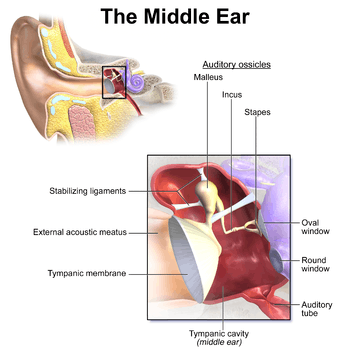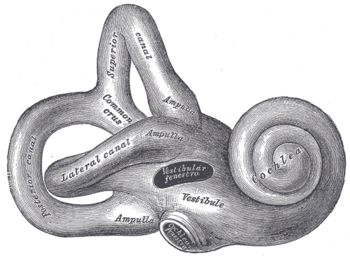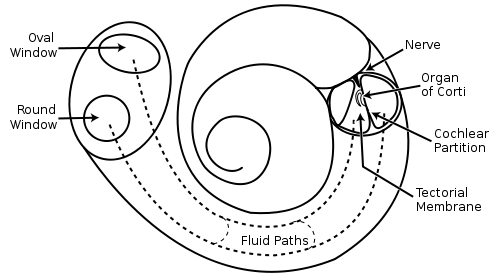Oval window
| Oval window | |
|---|---|
 Middle ear, with oval window at right. | |
 Right osseous labyrinth. Lateral view (label is vestibular fenestra — black circle near center) | |
| Details | |
| Identifiers | |
| Latin |
Fenestra vestibuli, fenestra ovalis |
| MeSH | D010046 |
| TA | A15.3.02.009 |
| FMA | 56913 |
| Anatomical terminology | |
The oval window (or fenestra vestibuli) is a membrane-covered opening that leads from the middle ear to the vestibule of the inner ear.
Vibrations that contact the tympanic membrane travel through the three ossicles and into the inner ear. The oval window is the intersection of the middle ear with the inner ear and is directly contacted by the stapes; by the time vibrations reach the oval window, they have been amplified over 10 times[1] from what they were when they contacted the tympanic membrane, a testament to the amplifying power of the middle ear.
It is a reniform (kidney-shaped) opening leading from the tympanic cavity into the vestibule of the internal ear; its long diameter is horizontal and its convex border is upward. It is occupied by the base of the stapes, the circumference of which is fixed by the annular ligament to the margin of the foramen.
Additional images
 View of the inner wall of the eardrum (label is fen. oval. — black circle near top)
View of the inner wall of the eardrum (label is fen. oval. — black circle near top) Cochlea
Cochlea
See also
- Round window
- This article incorporates text in the public domain from page 1040 of the 20th edition of Gray's Anatomy (1918)
References
- ↑ Moore and Dalley. Clinically Oriented Anatomy. 4th edition; 1999. p 971.
External links
- Diagram at Washington University
- The Anatomy Wiz. Oval Window